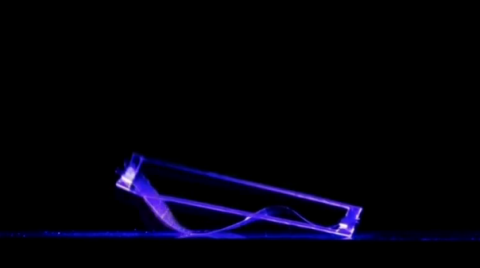
EINDHOVEN, Netherlands (Reuters) — Researchers say they have developed a new polymer material which can ‘walk’ when a single fixed light source shines upon it.
Co-lead author Dirk Jan Mulder, of Eindhoven University of Technology (TU/e) told Reuters: “The special type of plastic is made of a liquid crystalline polymer, which means they are built out of compounds like liquid crystals that we see in (LCD) displays. They have a certain order in them which we use to get this deformation going. We added to this polymer a light responsive compound.”
Motion is created by one side contracting in reaction to light, while the other side expands inside its rectangular plastic frame, making the wave bulge when illuminated.
The material looks transparent to the human eye, but fully absorbs the ultra-violet light used, creating a shadow behind it.
“What is crucial is the self-shadowing,” said co-lead author Anne Hélène Gélébart.
“We made this pre-curved shape, so that when the light comes onto the film it illuminates one part. The other part will be in shadow. As soon as the light goes on it deforms, placing another piece of the film in the light, and that one deforms, and so on.”
The polymer’s frame is shorter than the strip itself, causing it to bulge downward, creating a dent in the strip and allowing it to walk. When the frame – the size of a paperclip – is turned upside down the wave travels in the opposite direction, making it walk towards the light.
“This plastic frame maintains this constraint and creates this undulating motion,” said Gélébart.
The polymer can move at about half a centimeter per second. Researchers think it could be used as small robotic material that crawls by itself into narrow spaces, directed by light, moving small items in hard-to-reach places.
In tests researchers placed grains of sand on the strip, which were removed by the undulating movement.
“If we apply this material on solar panels in the desert and a sandstorm dirties the panels, this material is able to undulate and get rid of the sand,” said Mulder.
The study, carried out by researchers from TU/e and Kent State University, was published in scientific journal Nature in June.








